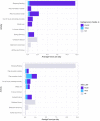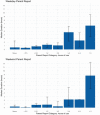Beyond Screen Time: A Synergistic Approach to a More Comprehensive Assessment of Family Media Exposure During Early Childhood
- PMID: 32754078
- PMCID: PMC7365934
- DOI: 10.3389/fpsyg.2020.01283
Beyond Screen Time: A Synergistic Approach to a More Comprehensive Assessment of Family Media Exposure During Early Childhood
Abstract
Digital media availability has surged over the past decade. Because of a lack of comprehensive measurement tools, this rapid growth in access to digital media is accompanied by a scarcity of research examining the family media context and sociocognitive outcomes. There is also little cross-cultural research in families with young children. Modern media are mobile, interactive, and often short in duration, making them difficult to remember when caregivers respond to surveys about media use. The Comprehensive Assessment of Family Media Exposure (CAFE) Consortium has developed a novel tool to measure household media use through a web-based questionnaire, time-use diary, and passive-sensing app installed on family mobile devices. The goal of developing a comprehensive assessment of family media exposure was to take into account the contextual factors of media use and improve upon the limitations of existing self-report measures, while creating a consistent, scalable, and cost-effective tool. The CAFE tool captures the content and context of early media exposure and addresses the limitations of prior media measurement approaches. Preliminary data collected using this measure have been integrated into a shared visualization platform. In this perspective article, we take a tools-of-the-trade approach (Oakes, 2010) to describe four challenges associated with measuring household media exposure in families with young children: measuring attitudes and practices; capturing content and context; measuring short bursts of mobile device usage; and integrating data to capture the complexity of household media usage. We illustrate how each of these challenges can be addressed with preliminary data collected with the CAFE tool and visualized on our dashboard. We conclude with future directions including plans to test reliability, validity, and generalizability of these measures.
Keywords: digital media; early childhood; household usage patterns; joint media engagement; passive sensing; technoference; time use activity data.
Copyright © 2020 Barr, Kirkorian, Radesky, Coyne, Nichols, Blanchfield, Rusnak, Stockdale, Ribner, Durnez, Epstein, Heimann, Koch, Sundqvist, Birberg-Thornberg, Konrad, Slussareff, Bus, Bellagamba and Fitzpatrick.
Figures











References
-
- Abidin R. R. (1995). Parenting Stress Index: Professional Manual, 3rd Edn Lutz, FL: Psychological Assessment Resources, Inc.
-
- Acevedo-Polakovich I. D., Lorch E. P., Milich R., Ashby R. D. (2006). Disentangling the relation between television viewing and cognitive processes in children with attention-deficit/hyperactivity disorder and comparison children. Arch. Pediatric. Adolesc. Med. 160 354–360. - PubMed
-
- Anand S., Krosnick J. (2005). Demographic predictors of media use among infants, toddlers, and preschoolers. Am. Behav. Sci. 48 539–561. 10.1177/0002764204271512 - DOI
-
- Anderson D. R., Field D. E., Collins P. A., Lorch E. P., Nathan J. G. (1985). Estimates of young children’s time with television: a methodological comparison of parent reports with time-lapse video home observation. Child Dev. 56 1345–1357. - PubMed
-
- Anderson D. R., Hanson K. G. (2017). Screen Media and Parent-Child Interactions. Media Exposure During Infancy and Early Childhood: The Effect of Content and Context on Learning and Development. New York, NY: Springer, 173–194.
LinkOut - more resources
Full Text Sources
Miscellaneous

